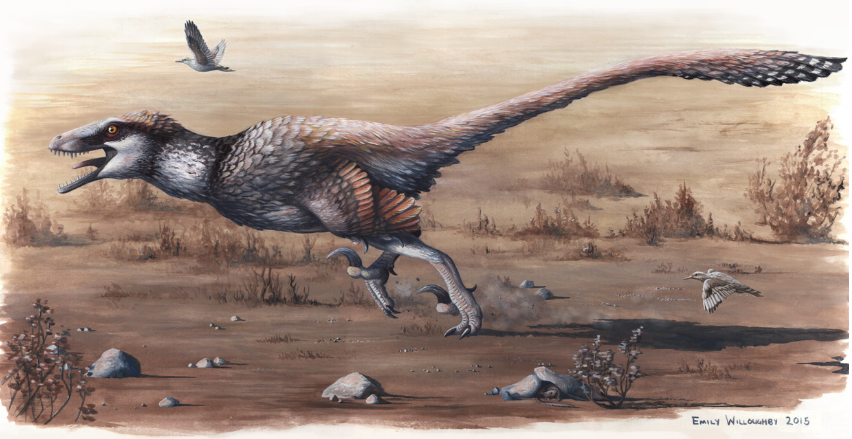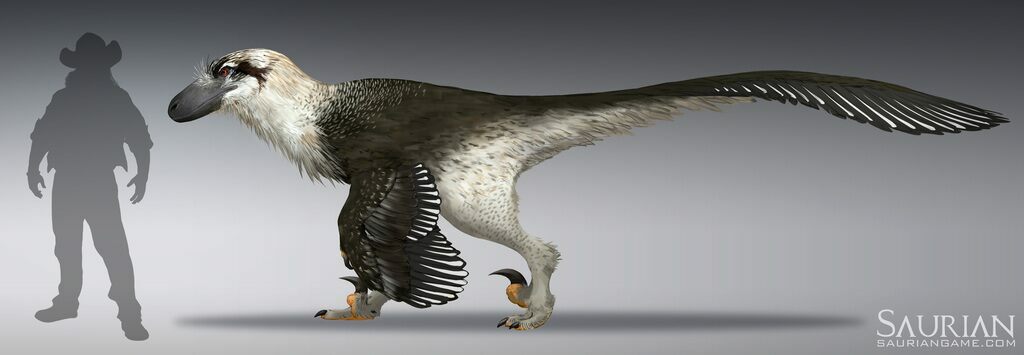Post by Cross on Nov 2, 2015 12:00:50 GMT 5
Dakotaraptor steini

Illustration by Emily Willoughby.
Temporal range: Late Cretaceous (Maastrichtian: ~66.8-66Ma)
Dakotaraptor steini is a derived dromaeosaurine dromaeosaurid from the Hell Creek formation, and is the first giant dromaeosaurid found there so far, with an estimated length of 5.5 meters. Described by Depalma et al. (2015) on the basis of the holotype skeleton PBMNH.P.10.113.T, which includes the femur, tibia, humerus, radius, ulna, mid dorsal centrum, several caudal vertebrae, a furcula, the D-II ungual, several tooth crowns, an astralagus, and a metatarsal.
The following text in italics are excerpts from the description paper :
Holotype.— PBMNH.P.10.113.T, an adult individual consisting
of right pedal ungual II; right pedal ungual III; right femur; left
and right tibiae; left astragalus and calcaneum; left metatarsals IIIV;
right metatarsal IV; one fragmentary dorsal centrum; 10 caudal
vertebrae; furcula; left and right humeri; left and right radii; left and right ulnae; right metacarpals I and II; three fragmentary left
manual phalanges.
Referred specimens.—PBMNH.P.10.115.T (gracile morphotype
right tibia); PBMNH.P.10.118.T (gracile morphotype left astragalus
and calcaneum); KUVP 152429 (gracile morphotype furcula), KUVP
156045 (isolated tooth) PBMNH.P.10.119.T, PBMNH.P.10.121.T,
PBMNH.P.10.122.T, PBMNH.P.10.124.T (isolated teeth); NCSM
13170, isolated furcula.
Diagnosis.—Dakotaraptor is diagnosed by the following characters;
1) an exceptionally large dromaeosaurid (approximately 5.5 m
reconstructed adult length, estimated using the tibiae and femora of
Dromaeosaurus, Deinonychus, and Utahraptor as a guide); 2) reduced
flexor tubercle on pedal ungual IV; 3) lateral corial groove on pedal
ungual IV is fully enclosed in a bone tube for about half of its distal
length; 4) sharp ventral keel on pedal unguals II and III; 5) fibular
crest is long, gracile, and its height does not exceed 9% of its total
length; 6) proximal margin of fibular crest is hooked; lateral condyle
of metacarpal II nearly the same size as medial condyle; 7) shallow
collateral ligament fossa on lateral side of metacarpal II; 8) proximodorsal
margin of metacarpal II is straight in dorsal view; 9) teeth
have 15-20 denticles/5 mm on distal carina and 20-27 denticles/5
mm on mesial carina; 10) pedal ungual II (straight measurement)
is approximately 29% of femur length.
Another reconstruction by RJ Palmer :

The D-II ungual (aka the "Killing claw") is 16cm long along the concave ventral surface and 24cm long along the convex dorsal surface. The tibia is 17% shorter than the femur, and according to the paper, resembles a scaled-up version of the femur of the basal dromaeosaurid Mahakala. The tibia:femur ratio is 1.21, relatively cursorial for a dromaeosaurid of this size, and contrasts the 1.1 ratio in Utahraptor ostrommaysorum.
(Excerpt) :
Femur.— The right femur is very intact and largely free of distortion
(Fig. 9). The overall long, narrow, and gracile morphology of
the femur resembles an enlarged version of Mahakala (Fig. 9A–C)
and many other small, agile dromaeosaurids and contrasts with the
stocky, robust femur of giant dromaeosaurids such as Achillobator or
Utahraptor (Kirkland, Burge, & Gaston, 1993). The length is 55.8
cm, about 17% smaller than the tibia, contrary to the nearly 1:1
ratio seen in Utahraptor and is more similar to virtually all other
dromaeosaurids (Norell & Makovicky, 2004). The shaft is anteriorly
bowed (Fig. 9B, 9C), although not to the extreme of Bambiraptor
(Burnham & others, 2000; Burnham, 2004). The femoral head is
subspherical and is perched at the tip of a neck (Fig. 9B). The lesser
trochanter is small, as in Saurornitholestes, and is separated from the
greater trochanter by a shallow sulcus. As in nearly all dromaeosaurids,
the fourth trochanter is virtually absent, present only as a smooth,
raised, elongated hump. On the posterodistal surface of the femur
is a proximodistally elongated, highly rugose ridge for attachment
of the adductor muscles.
The humerus and radius are robust, though oddly, the deltopectoral crest of the humerus is relatively weak. The ulna preserves several rows of ulnar papilli, which indicates the presence of quilled feathers, and the total estimated number of quilled feathers along the ulna is 15. Estimated total wingspan is 1.2 meters.
Two morphotypes of Dakotaraptor have been described. One is more gracile, the other slightly more robust. DePalma et al. (2015) link this to sexual dimorphism.
With a body length of 5.5 meters, Dakotaraptor is comparable in size to a juvenile T. rex, and may have occasionally competed with the juveniles for prey (while plausibly avoiding adults).
Reconstruction of the wings :

Reconstruction of Dakotaraptor using the "Raptor-Prey restraint" on Ornithomimus by Emily Willoughby :

![]()
--Reference
DePalma, Robert A.; Burnham, David A.; Martin, Larry D.; Larson, Peter L.; Bakker, Robert T. (2015). "The First Giant Raptor (Theropoda: Dromaeosauridae) from the Hell Creek Formation.". Paleontological Contributions (14).

Illustration by Emily Willoughby.
Temporal range: Late Cretaceous (Maastrichtian: ~66.8-66Ma)
Dakotaraptor steini is a derived dromaeosaurine dromaeosaurid from the Hell Creek formation, and is the first giant dromaeosaurid found there so far, with an estimated length of 5.5 meters. Described by Depalma et al. (2015) on the basis of the holotype skeleton PBMNH.P.10.113.T, which includes the femur, tibia, humerus, radius, ulna, mid dorsal centrum, several caudal vertebrae, a furcula, the D-II ungual, several tooth crowns, an astralagus, and a metatarsal.
The following text in italics are excerpts from the description paper :
Holotype.— PBMNH.P.10.113.T, an adult individual consisting
of right pedal ungual II; right pedal ungual III; right femur; left
and right tibiae; left astragalus and calcaneum; left metatarsals IIIV;
right metatarsal IV; one fragmentary dorsal centrum; 10 caudal
vertebrae; furcula; left and right humeri; left and right radii; left and right ulnae; right metacarpals I and II; three fragmentary left
manual phalanges.
Referred specimens.—PBMNH.P.10.115.T (gracile morphotype
right tibia); PBMNH.P.10.118.T (gracile morphotype left astragalus
and calcaneum); KUVP 152429 (gracile morphotype furcula), KUVP
156045 (isolated tooth) PBMNH.P.10.119.T, PBMNH.P.10.121.T,
PBMNH.P.10.122.T, PBMNH.P.10.124.T (isolated teeth); NCSM
13170, isolated furcula.
Diagnosis.—Dakotaraptor is diagnosed by the following characters;
1) an exceptionally large dromaeosaurid (approximately 5.5 m
reconstructed adult length, estimated using the tibiae and femora of
Dromaeosaurus, Deinonychus, and Utahraptor as a guide); 2) reduced
flexor tubercle on pedal ungual IV; 3) lateral corial groove on pedal
ungual IV is fully enclosed in a bone tube for about half of its distal
length; 4) sharp ventral keel on pedal unguals II and III; 5) fibular
crest is long, gracile, and its height does not exceed 9% of its total
length; 6) proximal margin of fibular crest is hooked; lateral condyle
of metacarpal II nearly the same size as medial condyle; 7) shallow
collateral ligament fossa on lateral side of metacarpal II; 8) proximodorsal
margin of metacarpal II is straight in dorsal view; 9) teeth
have 15-20 denticles/5 mm on distal carina and 20-27 denticles/5
mm on mesial carina; 10) pedal ungual II (straight measurement)
is approximately 29% of femur length.
Another reconstruction by RJ Palmer :

The D-II ungual (aka the "Killing claw") is 16cm long along the concave ventral surface and 24cm long along the convex dorsal surface. The tibia is 17% shorter than the femur, and according to the paper, resembles a scaled-up version of the femur of the basal dromaeosaurid Mahakala. The tibia:femur ratio is 1.21, relatively cursorial for a dromaeosaurid of this size, and contrasts the 1.1 ratio in Utahraptor ostrommaysorum.
(Excerpt) :
Femur.— The right femur is very intact and largely free of distortion
(Fig. 9). The overall long, narrow, and gracile morphology of
the femur resembles an enlarged version of Mahakala (Fig. 9A–C)
and many other small, agile dromaeosaurids and contrasts with the
stocky, robust femur of giant dromaeosaurids such as Achillobator or
Utahraptor (Kirkland, Burge, & Gaston, 1993). The length is 55.8
cm, about 17% smaller than the tibia, contrary to the nearly 1:1
ratio seen in Utahraptor and is more similar to virtually all other
dromaeosaurids (Norell & Makovicky, 2004). The shaft is anteriorly
bowed (Fig. 9B, 9C), although not to the extreme of Bambiraptor
(Burnham & others, 2000; Burnham, 2004). The femoral head is
subspherical and is perched at the tip of a neck (Fig. 9B). The lesser
trochanter is small, as in Saurornitholestes, and is separated from the
greater trochanter by a shallow sulcus. As in nearly all dromaeosaurids,
the fourth trochanter is virtually absent, present only as a smooth,
raised, elongated hump. On the posterodistal surface of the femur
is a proximodistally elongated, highly rugose ridge for attachment
of the adductor muscles.
The humerus and radius are robust, though oddly, the deltopectoral crest of the humerus is relatively weak. The ulna preserves several rows of ulnar papilli, which indicates the presence of quilled feathers, and the total estimated number of quilled feathers along the ulna is 15. Estimated total wingspan is 1.2 meters.
Two morphotypes of Dakotaraptor have been described. One is more gracile, the other slightly more robust. DePalma et al. (2015) link this to sexual dimorphism.
With a body length of 5.5 meters, Dakotaraptor is comparable in size to a juvenile T. rex, and may have occasionally competed with the juveniles for prey (while plausibly avoiding adults).
Reconstruction of the wings :

Reconstruction of Dakotaraptor using the "Raptor-Prey restraint" on Ornithomimus by Emily Willoughby :

--Reference
DePalma, Robert A.; Burnham, David A.; Martin, Larry D.; Larson, Peter L.; Bakker, Robert T. (2015). "The First Giant Raptor (Theropoda: Dromaeosauridae) from the Hell Creek Formation.". Paleontological Contributions (14).








